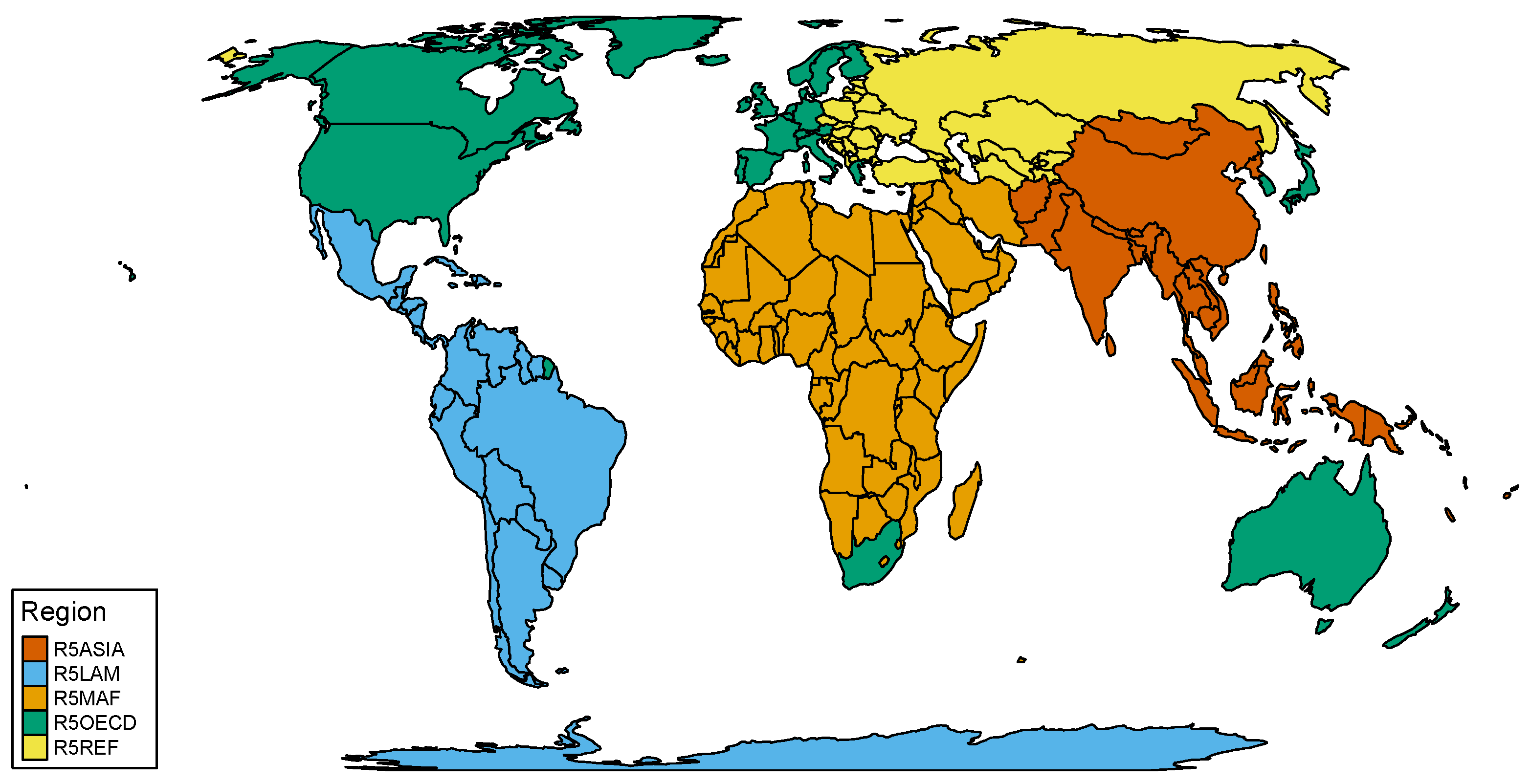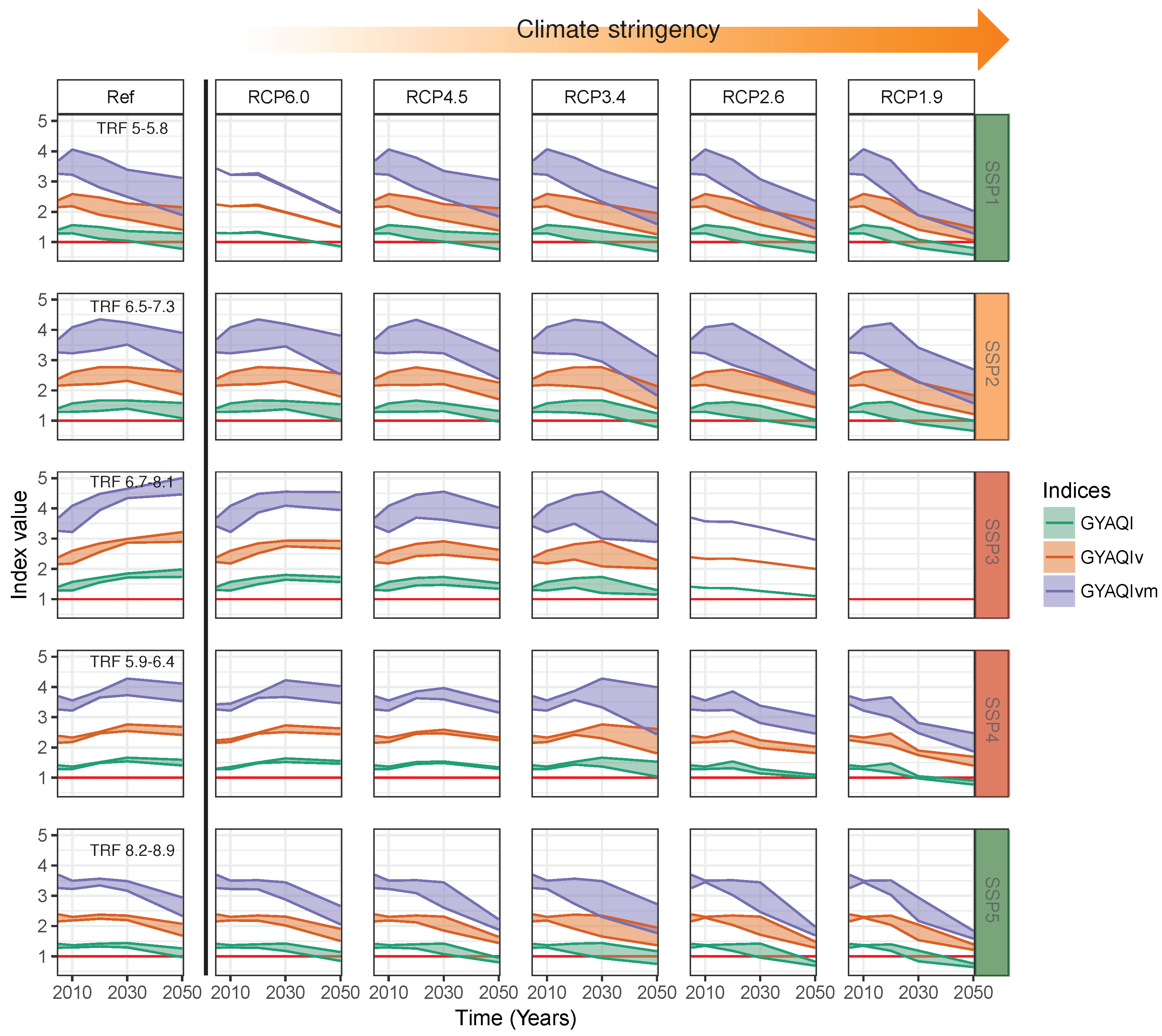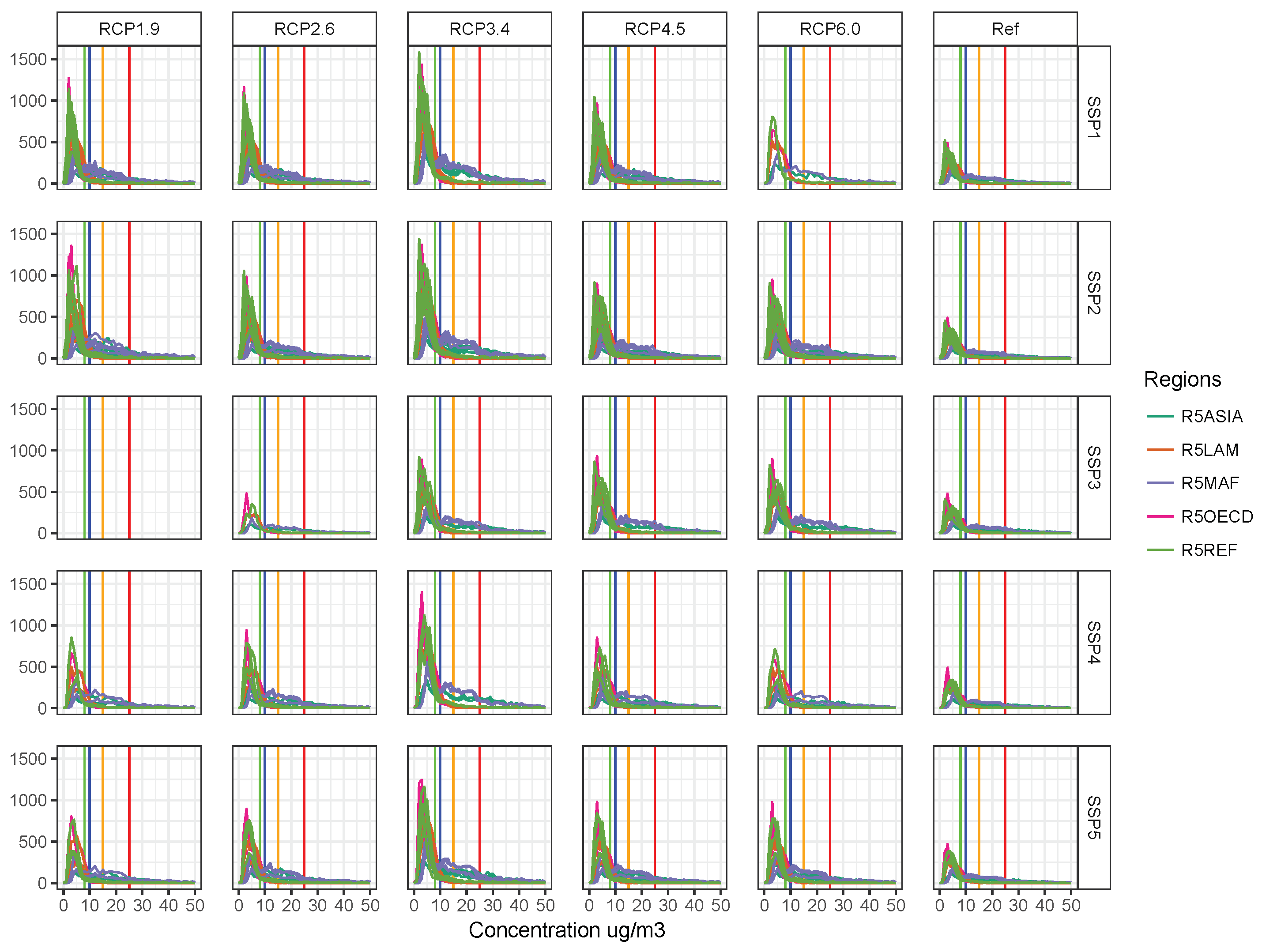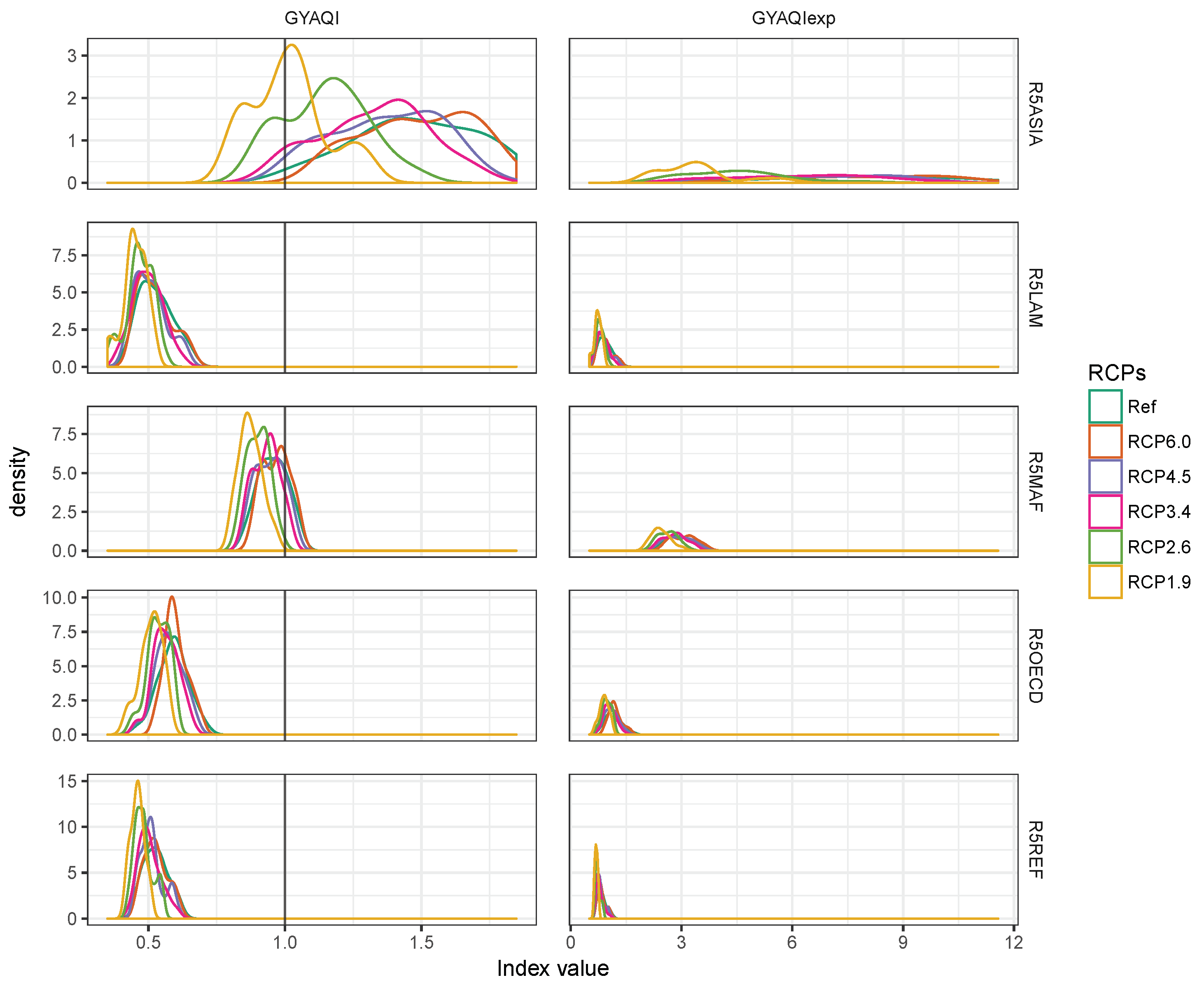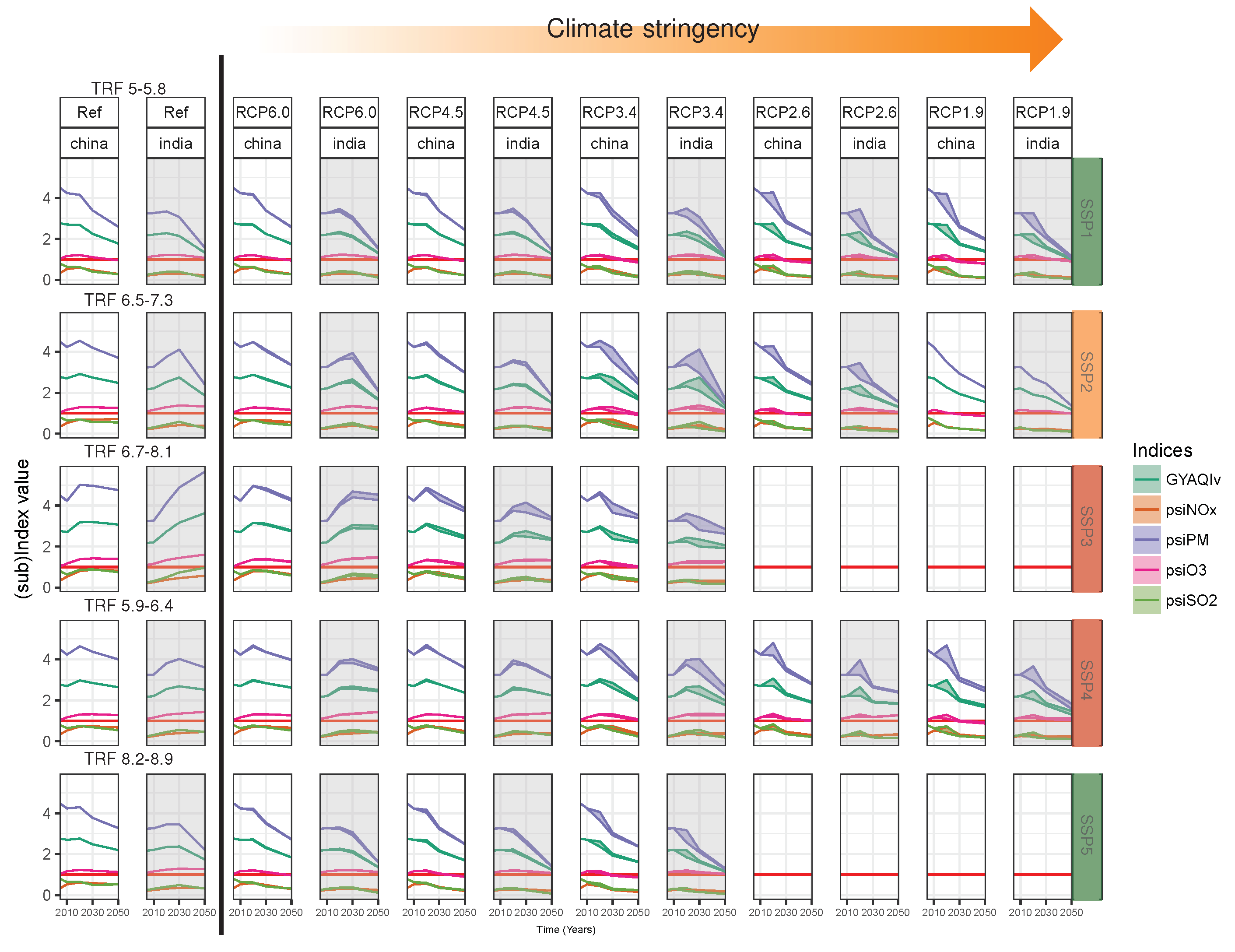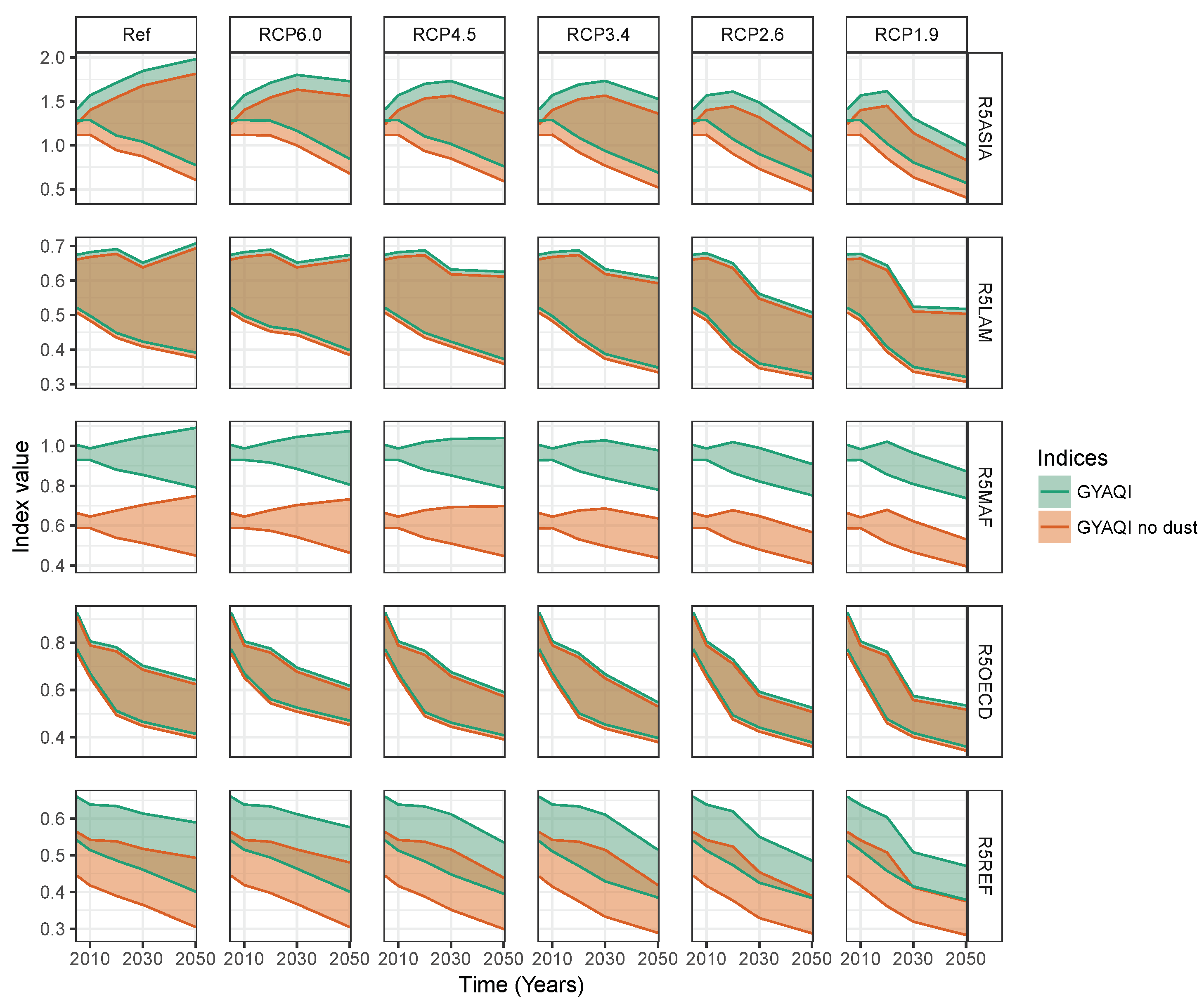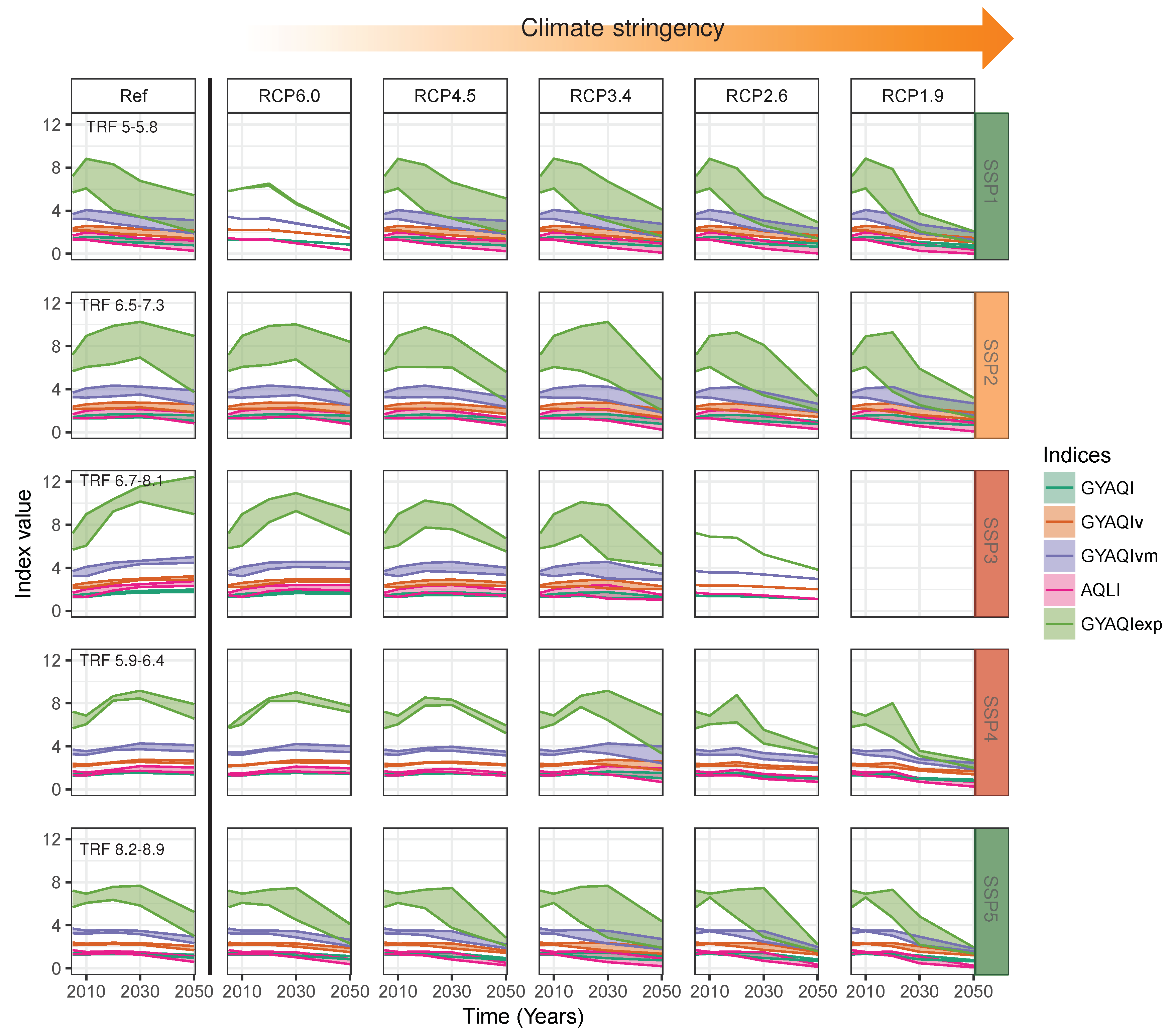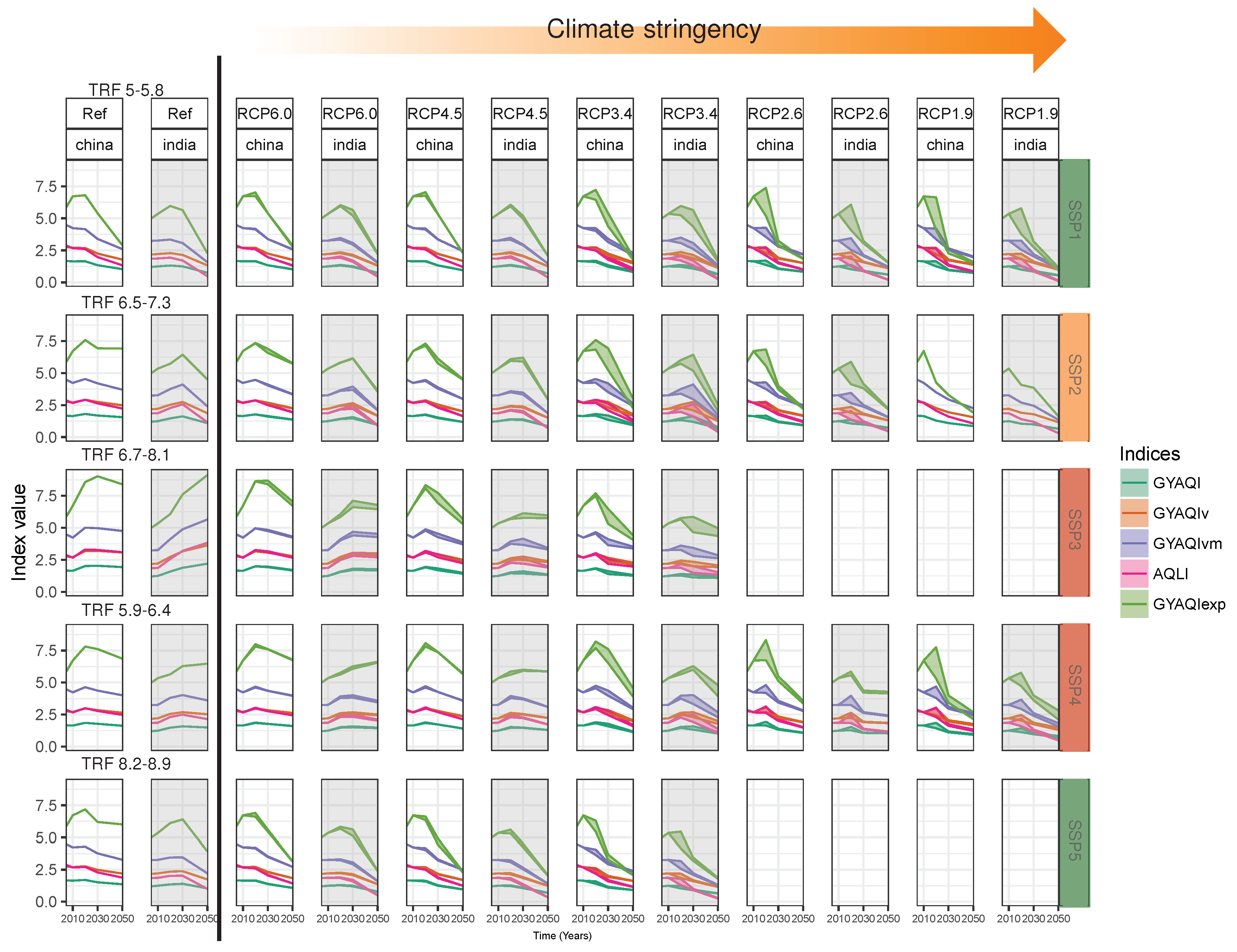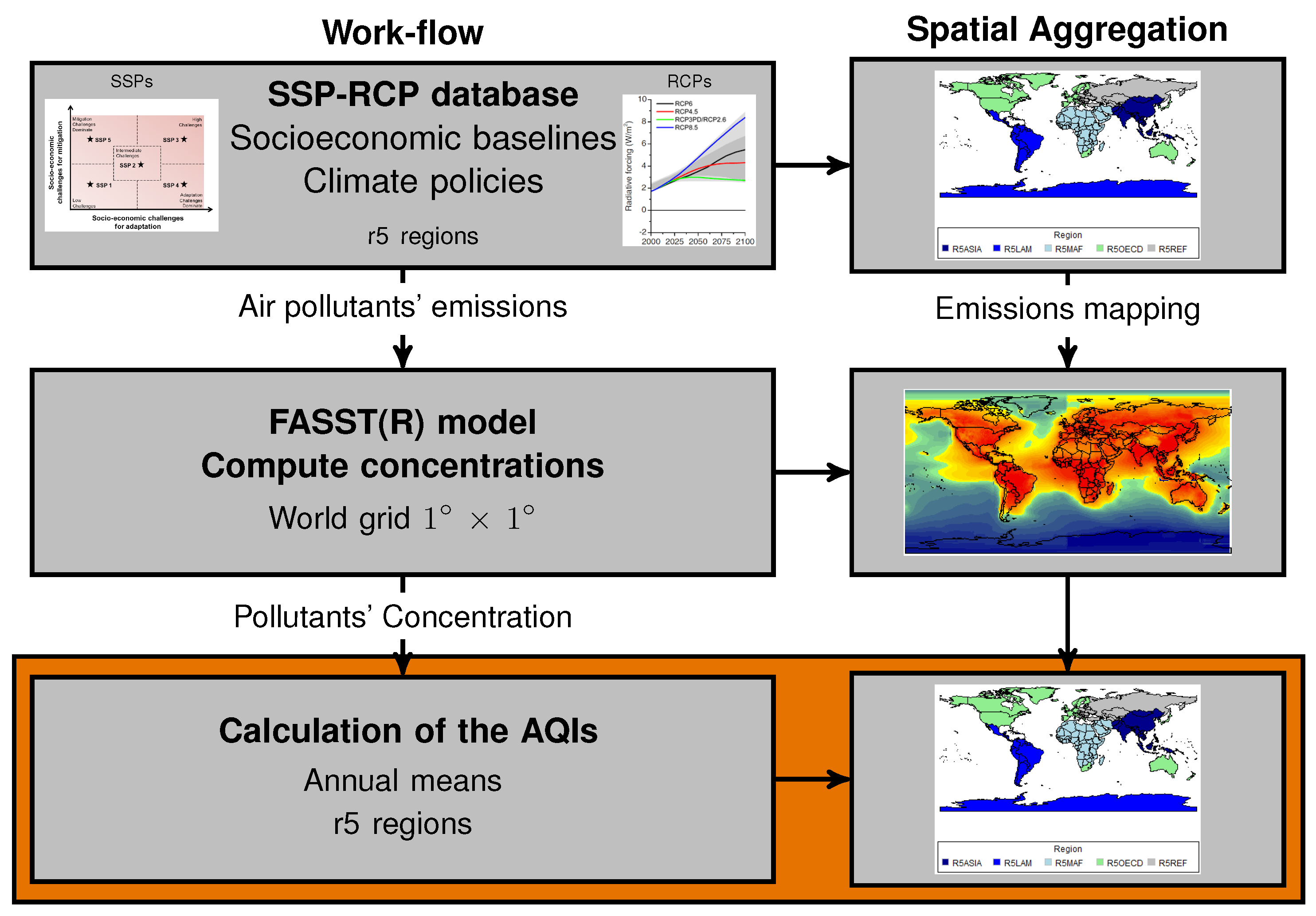1. Introduction
The agenda 2030 [
1] defines seventeen goals for sustainable development among which climate action, good health and well being, sustainable cities and life on land. Climate action and its co-benefits on air pollution relate to these goals and are crucial in defining future development policies.
The Integrated Assessment (IA) modeling community has produced in the recent decade a rich set of long-term future global scenarios. These scenarios focus mainly on global climate goals. Climate targets do not solely affect greenhouse gases levels but also air pollutants’ concentrations. The relationship between greenhouse gases mitigation and air pollution management is clear: both greenhouse gases and air pollutants are emitted by the combustion of fuels, and both influence radiative forcing. This is one of the reasons the IA community created an extensive database of air pollution pathways scenarios alongside the global mitigation scenarios [
2]. This information is important not only for assessing future global climate policies but also to guide and help air pollution plans.
Air pollution has been considered the most important environmental health-related problem by the World Heath Organization in 2014 [
3]. It is estimated that, in 2012, air pollution alone caused approximately seven million deaths around the world [
3,
4,
5]. Structured and careful air pollution policies and management can help reduce this problem and avoid a significant number of premature deaths due to poor air quality.
The air pollution scenarios produced by the IA community have already provided insights into the co-benefits that come along with climate policy implementation, as for instances in [
6,
7]. Most of these recent scenario exercises are based on the assumption that current and planned air pollution policies will be enforced and that, until the end of the century, these policies will become gradually more stringent. However, it is only recently that the baseline scenarios also include air pollution policies, linked with the underlying story-lines and assumptions, as in the Shared Socioeconomic Pathways (SSP) scenarios [
8].
The connection between climate and air pollution is significant enough to interfere with the safe achievement of the intended climate target. Climate targets are typically formulated over long time frames such as a century, while policy-makers have shorter governance cycles and are mainly concerned with short-term impacts on the population. Air pollution represents a stronger and more appealing argument than climate in the political agendas. In this context, it is crucial to understand how air pollution policies in conjunction with climate goals will play a role in locally achieving the legal air pollution objectives, more specifically the yearly air pollution limits.
In this study, we explore the SSP–RCP matrix of scenarios [
2,
9] to assess air quality policy implications across different socioeconomic pathways coupled with the global climate efforts to provide insights on the more sustainable policies to pursue. The SSP scenarios vary across many dimensions including Gross Domestic Product (GDP), population and urbanization [
10], and other sets of assumptions, such as technological development, environmental awareness and regional fragmentation. The SSPs establish air pollution policy pathways that evolve according to a storyline which depends on the different SSP baseline assumptions.
In the SSP scenarios, air pollution controls are implemented continuously through the implementation of End Of Pipe measures. However, the stringency and the speed at which each region adopts the control measures differ across SSP scenarios. These are stylized air pollution control scenarios that represent an average bulk of measures which are consistent with each of the SSP story-lines. They go from a mere implementation of the current air pollution legislation (SSP3 and SSP4: weak scenario in
Table 1) to the total deployment of the best available End Of Pipe technologies for each of the sectors (SSP1 and SSP5: strong scenario in
Table 1). While SSP1 (sustainability) and SSP5 (conventional development) foresee the widest and fastest deployment of air pollution controls, SSP3 (regional rivalry) and SSP4 (inequality) are the scenarios assuming the slowest implementation. The middle of the road scenario (SSP2) assumes significant advancement in pollution control, yet less than in SSP1 and SSP5. The details of the air pollution control storylines can be found in [
8] and in
Table A1. Climate policy objectives are applied to all SSPs by different integrated assessment models to cover a full range of climate radiative forcing levels, following the RCP targets [
11].
Air Quality Index (AQI) serves the purpose of aggregating otherwise extensive and complex information on single or multi-pollutant concentrations. This composite characteristic of the AQI allows accounting for several factors with a single value. Typically, these indices assemble information on the most important pollutants and provide information on the level of action, generally remediative, to be carried out both by the competent authorities and by the population. Ultimately, such indicators are helpful to inform on the expected impacts of air pollution on the population. A comprehensible definition was given by Shooter and Brimblecombe [
12]: “Air quality indices aim at expressing the concentration of individual pollutants on a common scale where effects, usually health effects, occur at a value that is common to all pollutants”.
Several types of AQIs have been developed, with multiple purposes and scopes. For detailed reviews of the AQIs, refer to Shooter and Brimblecombe [
12] and Plaia and Ruggieri [
13]. Traditionally, AQIs are used for real-time public information, but they differ in terms of the spatial aggregation method, number and type of pollutants considered, and on their time scale [
14,
15]. However, these AQIs have not been designed for a global and large-scale long-term assessment of air pollution risk exposure to compare global policies, especially not related to climate policy objectives and socioeconomic drivers. The CITEAIR II project [
16] proposed the Yearly Average Common Air Quality Index (YACAQI), which is used to compare air quality in European cities and it is one of the most recent indices that uses annual averages. Similarly, the Energy Policy Institute at The University of Chicago has calculated the Air Quality-Life Index (AQLI) which maps the life years lost per person from ambient PM
concentrations above a given limit, either set by local governments or by the World Heath Organization [
17].
In this paper, we explore a range of global AQIs that are adaptable to the time and spatial resolution of the emissions generated by global IA models. We produce information on long-term global air pollution policy planning and annual co-benefits, instead of the more conventional approach of using AQI for real-time or near future (order of days) information. This is crucial to inform climate policy and air pollution annual strategies based on the evolution of key socioeconomic factors.
The integrated assessment models (IAMs) produce emission pathways for several pollutants, such as Sulfur dioxide (SO), Nitrogen oxides (NOx), Organic Carbon (OC), Black Carbon (BC), Volatile Organic Carbon (VOC), carbon monoxide (CO) and ammonia (NH). These emissions are typically computed throughout the 21st century at 5- or 10-year time steps. The level of spatial detail is low, in the range of around 5–30 world regions. To harmonize the results across models, to allow comparability, these are often further aggregated to even larger macro-regions. Such high level of spatiotemporal aggregation poses important challenges and limitations to the design of AQI, which should be adaptable to the data provided by an IAM, include multi-pollutant information to account for air pollution synergistic effects, and at the same time must be meaningful for integrated policy decision at these spatial and temporal scales. The task of developing an AQI that provides long-term information to policy-makers is challenging. First, the future is unknown, and the projection has to be made from plausible scenarios which also contain very limited regional and temporal resolution detail. Accordingly, the AQI must be comparable amongst all regions to establish a consistent evaluation of the future air pollution pathways.
The global scope of this work does not directly provide insights into local sectoral specific policies. Rather, it contributes to positioning the local and national policies on air pollution in the context of global climate policies and the global macroeconomic development which is only possible with the help of global IAMs. In addition to the computed AQIs themselves, it provides a framework for air quality indices calculation for long-term integrated policies, which rely on aggregated information (indices) to evaluate the sustainability of multi-objective policies or co-benefits.
The aim of this paper is to provide a regional evaluation at the global level of future air quality based on a range of different socioeconomic scenarios framed in the context of global climate change policy. This work attempts to provide information to assist policy-makers with the design of their policies when negotiating climate goals and commitment strategies. We provide information on the accomplishment of future regional air pollution goals as a co-benefit of climate policies and socioeconomic development. This will help to understand the importance of air pollution in the context of global climate policies. The AQIs are strongly dependent on their underlying assumptions, such as mathematical formulation and the definition of the harmful thresholds. Therefore, we do not rely on a single AQI, but we analyze a range of possible AQIs and discuss their meaning and pertinence for policy making at this scale. We set out to assess the consequences in terms of future air quality around the world based on the most recent scenario exercise for the IPCC’s next assessment report, namely the SSP–RCP scenario matrix [
2]. The pollutant pathways are provided by the SSP database and represent a range of socioeconomic scenarios each with a corresponding air pollution emissions storyline coupled with climate targets represented by the RCPs (Representative Concentration Pathways), which establish radiative forcing targets. This is to our knowledge the first attempt to assess multi-pollutant future air pollution, through the use of AQIs, based on different scenarios of socioeconomic assumptions and climate targets.
In the Results section we present the results of the several AQI across the SSP–RCP scenario matrix. First, we present the global population average indicator (Global Yearly Average Air Quality Index, GYAQI) for all the macro regions and we discuss the regional variations. Secondly, we show possible variations of this index to overcome the multi-pollutant averaging issues. Furthermore, we introduce the exposure indices and explain how they vary across the different types of policies. Finally, we discuss in more detail the regional exposure results. The Methods section includes the design of the AQIs and the framework for the calculation of the results. Finally, we draw the conclusions.
2. Results and Discussion
2.1. The GYAQI under Different Socioeconomic Developments
Considering the reference scenario (“Ref”) in
Figure 1, where no climate policy is considered, one region excels as a real future challenge for air pollution legislation compliance, the region of Asia. This challenge is even more evident in SSP3, SSP4 and SSP2, with the GYAQI showing values above one throughout the whole second half of the century. The SSP3 (regional rivalry) scenario shows an increasing trend with time only inverted by climate policy, however keeping the values above the limits. The poor air quality in Asia is coming from the fossil fuel supply which is expected to grow in all the SSP baselines, contrary to the OECD region where oil supply will flatten or decrease. This combined with the mild air quality policies of SSP3 leads to poor air quality. Asia has the highest oil and coal primary energy production, and biomass supply is generally foreseen to rise more in Asia than in others regions. In this case, the air pollution controls foreseen in SSP3 are not enough to keep the GYAQI levels in Asia to the composite limit levels. Energy use will also be key to bend the trend curve of the GYAQI towards a decreasing trajectory after 2030, as explained by the difference between SSP3 and SSP4, which both assume the same air quality policies but differ on the energy demand and supply side. Climate policies, as seen by the stringency of the RCP targets, will be key to lower pollution as we observe that as the climate targets tighten the GYAQI approaches the value one. However, only the climate target set by the Paris agreement (RCP1.9, which corresponds to 1.5
C) prevents the GYAQI, independently of the socioeconomic assumptions, from assuming values above one by the middle of the century.
The Middle East and African region have a GYAQI that is generally dangerously close to one, and in the case of SSP3 combined with no climate policy or mild climate polices, it will exceed the composite limit. In this case the PM
sub-index is responsible for the higher values of the composite index. It is important to note that PM
in Middle East and Africa is strongly driven by the natural dust, which is one of the reasons the trend does not undergo drastic decreases even for very stringent policies (
Figure A8). The other reason is that the ozone sub-index trends have a flat behaviour around the value one.
For both regions, Asia and Middle East and Africa, unlocking international climate agreements are crucial to bring air pollution levels less harmful levels. When negotiating climate targets these regions would benefit from a global optimal emission pathway to lower their national air pollution.
Other regions do not present exceedances to the defined composite standard limits when analyzing the GYAQI, for all the SSP–RCP combinations. In OECD, we observe a general constant decrease on the GYAQI until 2050. The Latin American (LAM) and the reforming economies (REF) regions also see a decrease, although smoother.
The GYAQI is a multi-pollutant index that averages all the pollutants with equal weights. However, this could potentially be problematic, since it might hide pollutant-specific problems. To overcome come this drawback, we look at the pollutant sub-indices () and the variant of GYAQI, namely GYAQIv, which focuses on the two most problematic pollutants, fine particulate matter and ozone.
Figure 2 shows the sub-indices
and the GYAQIv index for Asia. The GYAQIvm, which takes the maximum sub-index instead of the average, is given by the highest
in the figure. The sub-indices results show that PM
and ozone are the most problematic pollutants in Asia, being almost constantly above the limits. Neither the climate policies nor the air pollution controls would be enough to avoid PM
exceedances, the best outcome is found for SSP1 (Sustainability) and the most stringent climate policies, however, the value is still above the limit. SSP5 (fossil-fuel development) also shows similar results but the lower bound of
PM2.5 in SSP1 is lower. Note that the narrower ranges of the SSP5 scenario are not necessarily due to less model uncertainty, but rather to the lower number of models implementing this scenario. When comparing SSPs, the SSP1 still turns out to be the scenario that offers the largest possible air quality improvement, with its lower bounds being lower than in SSP5, for all RCP targets, except RCP6.0, and all regions. The ozone sub-index varies in a narrower range (0.8–1.4), the Paris agreement climate target (RCP1.9) assures that ozone will respect the defined limit under all the socioeconomic assumptions by 2050. However, the most stringent air pollution controls and most sustainable socioeconomic assumptions (SSP1) might also be enough to keep ozone under the limit by 2050, as the lower bound of SSP1-Ref is lower than one.
The detailed analysis of the sub-indices reveals that the region of Middle East and Africa will also experience air pollution problems, mainly coming from ozone, which has, similarly to Asia, a very flat profile ( of 0.9–12) revealing the difficulties in tackling this pollutant. Ozone is a secondary pollutant, i.e., its concentration depends on other pollutants and meteorology in a non-linear relationship, making ozone-targeted policies is more complicated.
Figure 2 also highlights the importance of considering indices that are multi-pollutant composites but are less dependent on averages. The GYAQIv and GYAQIvm (graphically given by the highest sub-index) reveal that air pollution problems still persist by 2050 even if, in general, the air quality improves. The study of the pollutant’s sub-indices shows high adequacy of AQIs which are less sensitive to averages. Both GYAQIv and GYAQIvm exhibit the air pollution problems that were otherwise hidden due to the low values of NO
x and SO
(see
Figure A2).
Undoubtedly, the air pollution emissions pathways induced by socioeconomic development will be important to improve regional air quality. This is translated by the lower limit bound of the more stringent climate scenarios and also by the narrowing of the model range (
Figure 2). However, these levels are not enough to be considered as safe and the climate policies will play a more crucial role, in particular in the mid-century, which is consistent with previous studies [
7]. This is especially important for PM
pollution which is one of the most worrisome pollutants in terms of human health impacts. All models agree that, from 2030 to 2050, in all SSPs, an RCP1.9 climate policy, consistent with 1.5
C degrees, would prevent all regions of the world from exceeding the annual population-weighted average limit for all the pollutants, except PM
.
2.2. AQIs and Climate Policies
The pollutant-specific indices bring clarity to the results of the multi-pollutant AQIs. However, they do not inform the policy-makers on whether large parts of the population are exposed to high levels of pollution.
Figure 3 shows the AQIs results for Asia where more pollution problems are expected to arise (see population exposure in
Figure A3).
Exposure indicators, the GYAQIexp and the AQLI, are more responsive as both the concentrations and fractions of exposed population vary. The GYAQIexp penalizes high levels of exposure and the AQLI measures the years lost due to non-compliance of the limits. In Asia, GYAQIexp never equals GYAQI (i.e., there is always a fraction of the population exposed to at least the double of the limit values) independently of the socioeconomic conditions and the climate policies.
Air pollution policies seem to play a more crucial role in reducing the exposure AQIs than when considering the non-exposure AQIs. This is also observed in
Table 2, where the range of the medians across RCPs is lower than the minimum to maximum range within each RCP. Similar to before, the best air quality is seen when both stringent climate policies and SSP1 or SSP5 are enforced.
This can be seen looking at the GYAQIexp, reaching values close to the GYAQI, and the lower bounds of the AQLI achieving values under one year of life lost by 2050. The results of the AQLI found for the beginning of the century are compatible with the ones found in [
17], although the limit is not the same. SSP1 achieves lower levels of premature years lost with milder climate policies as the lower bounds of the AQLI levels are the lowest compared with the other socioeconomic scenarios. On the other hand, SSP3 foresees more than two years of life lost in Asia by 2050 for all climate targets, and more than three years of life lost in the case of SSP3-Ref. Climate policies will help in SSP3 to reduce the AQLI to around one or more years lost after 2030 with RCP4.5 and more stringent, still unfolding important values of the exposure AQIs. In general, the climate policies will not impact so much on the magnitude of the AQLI value but will mainly increase the speed at which those levels are achieved.
The GYAQIexp shows a broader range of values, as there are many levels of penalty depending on the magnitude of the exceedance. The “Ref” scenario shows that SSP3 and SSP4 alone expose significant fractions of the population to high levels with GYAQIexp always significantly above the GYAQI. Again, the socioeconomic assumptions of SSP4 are more favourable than in SSP3, as we observe a decreasing trend after 2030 in SSP4 even without climate policies. In the other SSPs, the lower bound is closer to the GYAQI level in 2050, meaning that air pollution policies reduce exposure, however only after 2030, with the exception of SSP1 and SSP2, where the decreasing trend of the GYAQIexp starts earlier.
The impact of climate policies becomes more important after 2030, where both the range of the GYAQIexp narrows and the values decrease to levels closer to the GYAQI, although still very high in the Asian region. Similar to the “Ref” case, SSP3 and SSP4 show high values of the GYAQIexp which remains substantially high even with the most stringent climate policy. The SSP3 is incompatible with RCP1.9 and RCP2.6 (only one model solved SSP3–RCP2.6) indicating that this combination is unlikely to happen. However, the only result available shows that the air pollution problem in Asia would most probably be left unsolved in the case of GYAQIexp. In SSP5, the decrease provoked by the climate policies is slower than in SSP1, although the lower bounds show a faster decrease than in SSP2 where some models predict important air pollution exposure levels even with very stringent climate policies. The analysis of the exposure indices shows that climate policies do not lead to good air quality, even if they help to reduce significantly exposure by the mid-century, there will be populations exposed to very high levels of pollution. Under these climate stringent policies, not only coal and oil supply are significantly reduced, but also the gas production leading to lower air pollution levels.
The regions that struggle more with pollution problems have much to benefit from a global climate policy. Climate change is a global problem, thus mitigating GHG can be carried out where the marginal abatement costs are lower worldwide, which means that cost-efficient international efforts will lead to investments in the regions that most need air pollution reductions due to lower abatement costs. This will be important for regions such as Asia, especially in India, reducing greatly the air pollution exposure.
2.3. The Regional Multi-Pollution Challenge
2.3.1. Asia
In Asia (
Figure 2 and
Figure 3), air pollution is driven mainly by PM
and ozone. SO
and NO
x show values constantly under the defined standard limits, with nitrogen oxides showing a flatter profile over time, only increasing regularly in SSP3 under very mild climate policies leading to high emissions in the industrial and transport sector. SO
shows a decreasing trend for all scenarios, except in SSP3 in the Reference scenario. The implementation of air pollution controls enforced in the other SSPs provokes the decrease and, in the case of SSP3, the climate policies restrict the coal use as they become more stringent.
Ozone remains one of the most problematic pollutants: all models foresee exceedances until 2030. Only SSP1 and SSP5 air pollution controls and socioeconomic assumptions show a decreasing trend in the absence of climate policies. For ozone, climate policies are more important than socioeconomic development. However, they are not as effective in bringing down the ozone concentrations as compared with other pollutants.
It is the ensemble of both climate and socioeconomic “greener” scenarios SSP1/2–RCP1.9, that assures, for all models, no exceedances of seasonal ozone limits by 2050. The SSP3 scenario always unfolds a world where ozone is above the standards in Asia. In SSP1, the lower limits of the model range prove possible to be below the limits even with no climate policy in Asia. The PM sub-index shows a behaviour similar to that of ozone. Asian back carbon emissions, especially in the transport and industry sectors, are the highest amongst the world regions, except in the power sector where they follow a pattern similar to that of the OECD region.
Analyzing the fractions of the population above the standard PM
levels (
Figure A3) shows that the SSP3 socioeconomic assumptions are the most damaging regarding pollution exposure where we observe significant fractions of the population (more than
) exposed to PM
levels twice the limits and more than half of the population exposed to values three times higher than the threshold. Climate policies are effective in decreasing the endangered fraction of the population, especially to avoid exposures above twice the limit and especially after 2030.
Asia is a major macro-region that includes two of the major polluting countries in the world, China and India. The recent commitments of the Paris agreement and the enforcement of the national air pollution plans show two different ambitions what concerns both air pollution and climate goals. To study this in a greater detail, we analyze the results of the SSP–RCP scenario exercise of the model WITCH-GLOBIOM that includes these two countries separately.
Figure 4 and
Figure A7 show the indices and the sub-indices for these countries. The exposure index GYAQIexp shows higher values than the macro-region results, because in both India and China the fractions of exposed population to extremely high values (i.e.,
) is zero, whereas in the whole macro-region of Asia there are exposures to extremely high values. On the other hand, India shows lower values than the Asia region. The most interesting aspect is the difference in trends. Looking at SSP3 and SSP4, when no climate policy is in place, one observes that China peaks its AQIs earlier than India and inverts the trend of the exposure indicator (GYAQIexp), whereas in India in SSP3 this trend does not invert and the AQIs values keep increasing over time. The air pollution controls and socioeconomic assumptions of SSP2, SSP3 and SSP4 are more important in India than in China where the intensive economic growth will maintain the AQI levels high even if with a decreasing trend towards the middle of the century. Climate policy in India will act faster than in China, but this is not surprising since decarbonization is happening first in India where the marginal abatement cost is lower.
2.3.2. Latin America
In the Latin America region, the indices show good scores indicating that the annual averaged air quality limits will probably be respected. The levels of ozone, PM
, SO
and NO
x will remain under the limits. All the pollutants show decreasing trends, except PM
which stays flat from 2030 to 2050 in SSP2 and SSP3. Despite that, half of the population will remain above the PM
limit values, although extreme exposure will most probably not take place especially after 2030, with the exception of SSP3. A slight rebound increase at the end of the half century in SSP2 is observed and remain constant throughout time in SSP3. In SSP3, emissions increase and remain high in the industry and transport sectors due to continuous general high gas and oil supply even with climate policies in Latin America. Latin America shows one of the lowest AQLI (
Table 2), with few months of life lost due to PM
by 2030.
2.3.3. Middle East and Africa
The prominent challenge for the Middle East and Africa region regarding air pollution is ozone and PM
. In all scenario combinations, there is always a chance that ozone will exceed the season limit at some point in time, especially until 2030. Ozone itself is known to have important impacts on human health [
18].
In the case of SSP1, RCP3.4, or stringier, is enough to keep average ozone levels within limits by 2050. However, in SSP2, SSP4 and SSP5, only the most stringent climate policies will deliver good results. SSP3 will always deal with ozone exceedances independently of the climate policy, most probably due to the VOC emissions from the power and residential sectors which are the highest in the world. The wide use of oil and biomass at levels compared to OECD and Asia in the Middle East and Africa regions and the lower level of deployment of air pollution controls contribute to the high VOC emissions observed. Additionally, emissions from solvent use tend to increase over time and grassland burning emissions are very high in this region. These emissions are exogenous in most of the IAMs and they are therefore not reactive to climate policies.
In this region, people are very exposed and the vegetation might suffer high losses. Although the aggregate air quality index shows general compliance, the exposure indices show that important parts of the population will be exposed to values above the limit.
NO
x and SO
have values well below the limits. PM
shows high values and the AQLI is around 1.2 in all SSP–RCP combinations (
Table 2), with half of the population being exposed to concentrations twice the annual limits until 2030.
In what concerns PM
, it must be noticed that in this region a big share of this pollutant concentration comes from natural dust, as seen in
Figure A8. This impacts not only the PM
but also the composite indices. In the case of Middle East and Africa, the natural dust impact is very significant, and similar results are found in [
8].
2.3.4. OECD Countries
OECD is the region where the most efficient air pollution control policies are deployed in all SSPs. In what concerns the PM
exposure, low fractions of the population are exposed above very high limits. However, even with the very fast improvements by 2030 in any SSPs, about 25–50% of the total OECD population will be above the limit unless climate policies enter into force. In SSP1, the high exposures to PM
are substantially reduced by 2050, without the help of climate policies. The estimated years of life lost due to PM
exposure is of 0.17 years, in general (
Table 2).
Ozone is the other potential problem in the OECD region, remaining stable and dangerously close, but always below, the limit with soft improvements until 2050. As in the Middle East and Africa region, the VOC emissions in the power sector, due to the high supply of oil and biomass, and to some extent in solvent use might be responsible for the high ozone levels. Climate policies seem to play a marginal role in the case of ozone in OECD. On the other hand, it is the socioeconomic assumptions that will be determinant for ozone pollution in OECD, where SSP1 is enough to push down ozone concentrations even if not significantly, mainly due to the VOC emissions reductions in the industry and transport sectors. Similar to the other regions, both SO and NOx seem to be safely under the defined limits, with decreasing patterns in all the SSP–RCP combinations.
We analyze the specific results for the WITCH-GLOBIOM native regions within the OECD macro-region, USA, and Europe (divided into old and new Europe, where old represents the member of the European Union (EU) and new the non-EU members), shown in
Figure A9. As for the OECD region, we observe a steep decreasing trend in all the AQIs starting already in the first years of the century. However, within the OECD, we observe regional differences in the magnitude of the AQIs, with the non-EU members being above the OECD values, the EU members being under and the USA following closely with the OECD macro-region. The most problematic pollutant is PM
in non-EU members: its sub-index remains above the limit in these countries even SSP1–RCP1.9. All the pollutants sub-indices in EU are under the limits. However, even if the population weighted average indicates no problems, there will still be fractions of the population exposed to levels above the limit as seen by the exposure indices. The USA follows a path similar to that of the EU-members, dealing only with PM
exceedances at the very beginning of the century.
2.3.5. Reforming Economies of Eastern Europe and the Former Soviet Union
The Reforming Economies of Eastern Europe and the Former Soviet Union region is one of the regions where there is less uncertainty across models. Ozone, as in all the other regions, remains close to the limit. The power and residential sector NO
x emissions are probably the main drivers of ozone. SO
and NO
x are well below the limits. This region shows low AQLI index across all SSPs and RCPs, the fraction of exposed population is low and decreases sharply over time even with the most adverse socioeconomic drivers and without the help of climate policies. The PM
concentrations in this region are largely affected by the natural dust (
Figure A8), in all scenarios, PM
exposure decreases sharply over time, even if around 25% of the population will still be exposed to levels above the limit. Air pollution policies as taken into consideration in the different SSPs, seem more effective in all the pollutants sub-indices with respect to climate policies.
4. Conclusions
We developed a portfolio of AQIs that is adequate to the data provided by the IAM community and provides insight into future regional air quality at the global scale.
4.1. Climate Policy versus Socioeconomic Development
We have shown that both SSPs and climate policies play a role in air quality improvement. However, climate policies are generally more effective after 2030 in reducing air pollution, especially from ozone. The underlying assumptions behind the SSPs, on the other hand, seem to be more effective for PM
reductions, and have a greater impact on the magnitude of the results, while climate policies influence the speed of the reductions. This is visible in
Figure A5 and
Figure A6, where the “greener” socioeconomic assumptions (SSP1) show a narrower range than a 2
C policy (RCP2.6) across SSPs. Interestingly, however, the climate target set by the Paris agreement (1.5
C, i.e., RCP1.9) reverses this trend narrowing the indices probability distribution more than SSP1. All models agree that a 1.5
C policy would prevent all regions of the world from exceeding the annual population-weighted average limit of the multi-pollutant index (GYAQI) and of the sub-indices (
) of all the pollutants, except PM
.
Figure A5 shows that, when comparing the socioeconomic assumptions, SSP1 is the scenario where better air quality is achieved. In fact, in SSP1, the distribution always dominates the other SSPs. This is especially important when comparing with SSP5, which assumes the same emission controls as SSP1, but varies regarding energy use and other drivers, meaning that even when employing the best air pollution controls, the exploitation of fossil fuels and the use of energy intensive lifestyles is not compatible with the lowest achievements in terms of air pollution controls. The exception is the OECD region, where climate and air quality policies are already at a more advanced stage and climate policies have a lower impact. SSP3 is undoubtedly, as all models agree, the most problematic of the scenarios in terms of air quality, not only because it is incompatible with the most stringent climate policies, but also due to its air pollution control assumptions. On the contrary, the socioeconomic conditions of SSP5 are a threat to climate goals but are relatively advantageous from an air quality point of view. It is the overall evaluation of both goals that will determine the optimal policy. Overall, we find thus that the most sustainable socioeconomic development policy (SSP1) is also the one that yields better air quality and that increases the changes of climate policy success.
4.2. Regional Focus
The Asian region is the most challenging in terms of air quality compliance. OECD shows the highest improvements and Latin America poses the lowest pollution challenges. Different regions will experience different challenges: ozone is a pollutant of concern especially in OECD and Middle East and Africa, whereas PM will require particular attention worldwide, and especially in Asia where the population will be exposed to extreme concentrations in all regions. Additionally, we have explored the AQIs in some of the major economies, such as China, India, USA, and the European Union. China pollution peaks earlier than India, and shows in general a descending trend independently of the socioeconomic assumptions. However, when a climate policy is enforced in India, air pollution shows a steep descending pathway due to its lower CO marginal abatement costs. As carbon emissions are generally related to air pollution emissions, the fact that climate policy acts were the carbon abatement costs are lower will bring faster improvements to air quality helping to avoid more premature deaths. In this sense, climate policies, such as international agreements on limiting the average temperature increase will substantially reduce air pollution, especially for the regions where improvements are more important and affordable, such as India and China. In what concerns the developed economies, we found that the European Union experiences lower levels of the AQIs.
4.3. Choosing the Adequate AQI
We have explored several types of AQIs that can be used in global mid to long term integrated policy evaluation and to measure air quality co-benefit of global policies. We have discussed their adequacy and the pros and cons of each of the AQIs. They are presented in
Table 4 which summarizes our discussion of the different AQIs.
The multi-pollutant averaged air quality index “hides” possible concerns when other sub-indices are low enough to bring the average index down. The AQI variants (GYAIQv and GYAIQvm) isolate the effect of the most problematic pollutants, further highlighting the air pollution issue in Asia and bringing to light other potential problems in the other regions. Additionally, we present AQIs, such as the GYAQIexp and the AQLI, that consider population exposure to high and very high levels of pollution even when the greater annual regional average performs well. We conclude that the exposure AQIs are more adequate in the context of global policy because they provide more information and still allow for a single value score when comparing several integrated policies.
The construction of a composite index entails a loss of information. Nevertheless, it is very useful for many other reasons, such as general public information and awareness, civil society organizations, and policy making. As noted by Khordagui and Al-Ajmi [
41], indices can be used not only to inform the public but also to assist policy making either by evaluating air pollution measures or by supporting the policy optimization and ultimately to control legislative compliance.
The exposure AQIs proposed in this paper are useful for policy-makers when negotiating future climate commitments having in mind the regional air pollution pathways. They help to place future air quality in a range of plausible futures that might unfold. Additionally, as in this work, the new AQIs can be used to represent the health dimension when considering a multi-criteria welfare analysis of sustainable policies taking into account not only climate and pollution objectives but also socioeconomic goals. In this case, a single value is needed to aggregate comprehensive and valuable information on pollution impacts across a range of complex integrated policy scenarios. Finally, the SSP–RCP scenario analysis informs on the possible co-benefits of climate and socioeconomic policy providing top-down insights into annual regional air pollution levels which in turn could be used by higher resolution models to better study the local impacts of these policies.
4.4. Future Research
Our results isolate the effect of emission pathways on population-weighted averages to be able to detect how the SSP and RCP air pollution emission pathways impact the AQIs. This is undertaken by keeping the population patterns frozen for all scenarios when calculating the concentrations and not allowing the results to vary with population growth. A topic of future research could be the evaluation of how population growth and changes in population density spatial patterns affect exposure and the AQIs.
Additionally, as air pollution is just one of the aspects that qualify the impact of a policy, a major step forward would be to develop indicators for other aspects, such as biodiversity, water demand, land-use, forest management and equity and equality to be able to have an more complete integrated evaluation of the global policies. Moreover, although the AQLI already provides a measure of health impacts, in this study, we did not look into the cost of these policies or into how these scenarios would translate in terms of mortality numbers, which could be a line of further research.
